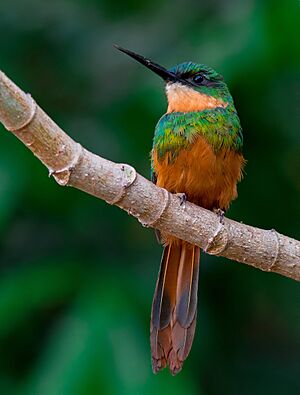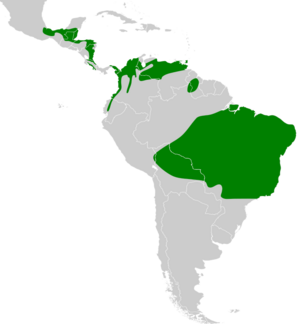Rufous-tailed jacamar facts for kids
Quick facts for kids Rufous-tailed jacamar |
|
|---|---|
 |
|
| Female, Brazil | |
| Conservation status | |
| Scientific classification | |
| Genus: |
Galbula
|
| Species: |
ruficauda
|
 |
|
The rufous-tailed jacamar (Galbula ruficauda) is a near-passerine bird which breeds in the tropical New World in southern Mexico, Central America and South America as far south as southern Brazil and Ecuador.
Contents
Description
Like other jacamars they are elegant, brightly coloured birds with long bills and tails. The rufous-tailed jacamar is typically 25 cm (10 in) long with a 5 cm (2 in) long black bill. The subspecies G. r. brevirostris has, as its name implies, a shorter bill. This bird is metallic green above, and the underparts are mainly orange, including the undertail, but there is a green breast band. Sexes differ in that the male has a white throat, and the female a buff throat; she also tends to have paler underparts. The race G. r. pallens has a copper-coloured back in both sexes.
Food and foraging
This insectivore hunts from a perch, sitting with its bill tilted up, then flying out to catch flying insects. One commonly preyed upon insect is the social wasp Agelaia vicina. Other insect prey include flies, beetles, bees, dragonflies, and butterflies. Further, the bird distinguishes between edible and unpalatable butterflies mainly according to body shape.
Nesting
This species is a resident breeder in a range of dry or moist woodlands and scrub. The two to four rufous-spotted white eggs are laid in a burrow in a bank or termite mound.
Vocalizations
The rufous-tailed jacamar's call is a sharp pee-op, and the song a high thin peeo-pee-peeo-pee-pe-pe, ending in a trill.





